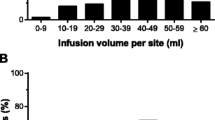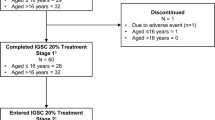Abstract
Patients with primary immunodeficiency diseases have been treated with intravenous gammaglobulin (IGIV) for over 20 years. Gamma globulins were first introduced as a therapeutic modality in 1952 by Robert A. Good, who injected gamma globulins by the intramuscular (IM) route to treat patients with X-linked agammaglobulinemia. Subsequently, the clinical indications for gamma globulins therapy expanded from patients with Bruton’s disease and other primary immune deficiency disorders to include a variety of autoimmune and inflammatory diseases. This expansion in clinical indications paralleled two critical steps in the development of gamma globulins preparations. First, proteolytic enzyme-treated immunoglobulins became available for intravenous (IV) administration; unlike earlier IM preparations, IV preparations could be administered in larger volumes, were less painful, rapidly achieved physiologic concentrations of serum IgG, and were similar to native immunoglobulins with respect to their distribution of IgG subclasses and their pharmacokinetic features. Newer, highly purified IGIVs also became available. Second, significant efforts have been made to enhance the viral safety of IGIVs. Manufacturers no longer depend on Cohn-Oncley or cold ethanol treatment as the only viral elimination step; rigorous donor screening, plasma testing by sensitive nucleic acid testing, and additional viral inactivation steps in the manufacturing processes for IGIVs have been implemented. In spite of the fact that this therapy has been life-saving in patients with primary immunodeficiency diseases, a number of adverse events have been reported as a result of its use. This paper will review some of the more frequent and important adverse events associated with the administration of IGIV, and discuss the mechanisms by which these reactions may occur. Our approach for replacement therapy with IGIV of patients with primary immunodeficiency diseases will be described, and some of the concerns related to the availability of commercial IGIV for this important patient population will be presented. Availability of IGIV product has been of particular concern to the clinical immunologists who take care of patients with primary immune deficiency disorders since there are no alternative therapies for these patients.
Similar content being viewed by others
References
Brennan VM, Salome-Bentley NJ, Chapel HM. Prospective audit of adverse reactions occurring in 459 primary antibody-deficient patients receiving intravenous immunoglobulin. Clin Exp Immunol 2003;133:247–51
Burks A, Sampson H, Buckley R. Anaphylactic reactions after gammaglobulin administration in patients with hypogammaglobulinemia. Detection of IgE antibodies to IgA. N Engl J Med 1986;314:560
Cunningham-Rundles C, Zhou Z, Mankarious S, Courter S. Long-term use of IgA-depleted intravenous immunoglobulin in immunodeficient subjects with anti-IgA antibodies. J Clin Immunol 1993;13:272–8
de Albuquerque Campos R, Sato MN, da Silva Duarte AJ. IgG Anti-IgA subclasses in common variable immunodeficiency and association with severe adverse reactions to intravenous immunoglobulin therapy. J Clin Immunol 2000;20:77–82
Anonymous. Renal insufficiency and failure associated with immune globulin intravenous therapy—United States, 1985–1998. MMWR Morb Mortal Wkly Rep 1999;48:518–21
Sekul EA, Cupler EJ, Dalakas MC. Aseptic meningitis associated with high-dose intravenous immunoglobulin therapy: frequency and risk factors. Ann Intern Med 1994;121:259–62
Pierce LR, Jain N. Risks associated with the use of intravenous immunoglobulin. Transfus Med Rev 2003;17:241–51
Dalakas MC, Clark WM. Strokes, thromboembolic events, and IVIg—Rare incidents blemish an excellent safety record. Neurology 2003;60:1736–7
Wolberg AS, Kon RH, Monroe DM, Hoffman M. Coagulation factor XI is a contaminant in intravenous immunoglobulin preparations. Am J Hematol 2000;65:30–4
Fisman DN, Smilovitch M. Intravenous immunoglobulin, blood viscosity and myocardial infarction. Can J Cardiol 1997;13:775–7
Bjoro K, Froland SS, Yun Z, Samdal HH, Haaland T. Hepatitis C infection in patients with primary hypogammaglobulinemia after treatment with contaminated immune globulin. N Engl J Med 1994;331:1607–11
Bresee JS, Mast EE, Coleman PJ, Baron M, Schonberger L, Alter J, et al. Hepatitis C virus infection associated with administration of intravenous immune globulin. JAMA 1996;276:1563–7
Rossi G, Tucci A, Cariani E, Ravaggi A, Rossini A, Radaeli E. Outbreak of hepatitis C virus infection in patients with hematologic disorders treated with intravenous immunoglobulins:different prognosis according to the immune status. Blood 1997;90:1309–14
Anonymous. Outbreak of hepatitis C associated with intravenous immunoglobulin administration-United States, October 1993-June 1994. MMWR 1994;43:505–9
Ballow M. Intravenous immunoglobulins: clinical experience and viral safety. J Am Pharm Assoc 2002;42:449–59
Johnson RT, Gibbs CJ Jr. Creutzfeldt-Jakob disease and related transmissible spongiform encephalopathies. New Engl J Med 1998;339:1994–2004
Brown P. Can Creutzfeldt-Jakob disease be transmitted by transfusion? Curr Opin Hematol 1995;2:472–7
Trejo SR, Hotta JA, Lebing W, Stenland C, Storms RE, Lee DC, et al. Evaluation of virus and prion reduction in a new intravenous immunoglobulin manufacturing process. Vox Sang 2003;84:176–87
Bernatowska E, Madalinski K, Janowicz W, Weremowicz R, Gutkowski P, Wolf HM, et al. Results of a prospective controlled two-dose crossover study with intravenous immunoglobulin and comparison (retrospective) with plasma treatment. Clin Immunol Immunopathol 1987;43:153–62
Roifman CM, Levison H, Gelfand EW. High-dose versus low-dose intravenous immunoglobulin in hypogammaglobulinaemia and chronic lung disease. Lancet 1987;1:1075–7
Liese JG, Wintergerst U, Tympner KD, Belohradsky BH. High- vs low-dose immunoglobulin therapy in the long-term treatment of x-linked agammaglobulinemia. AJDC 1992;146:335–9
Kainulainen L, Varpula M, Liippo K, Svedstrom E, Nikoskelainen J, Ruuskanen O. Pulmonary abnormalities in patients with primary hypogammaglobulinemia. J Allergy Clin Immunol 1999;104:1031–6
Quartier P, Debre M, DeBlie J, de Sauverzae R, Sayegh N, Jabado N. Early and prolonged intravenous immunoglobulin replacement therapy in childhood agammaglobulinemia: a retrospective survey of 31 patients. J Pediatrics 1999;134:589–96
Eibl MM, Wedgwood RJ. Intravenous immunoglobulin: a review. Immunodefic Rev 1989;1:1–42
Ashida ER, Saxon A. Home intravenous immunoglobulin by self-administration. J Clin Immunol 1986;6:306–9
Schiff R. Transmission of viral infections through intravenous immune globulin. N Engl J Med 1994;331:1649–50
Gardulf A, Andersen V, Bjorkander J, Ericson D, Froland SS, Gustafson R, et al. Subcutaneous immunoglobulin replacement in patients with primary antibody deficiencies: safety and costs. Lancet 1995;345:365–9
Berger M. Subcutaneous immunoglobulin replacement in primary immunodeficiencies. Clin Immunology 2004;112:1–7
Sacher RA, the IVIG Advisory Panel. Intravenous immunoglobulin consensus statement. J Allergy Clin Immunol 2001;108:S139–46
Milgrom H. Shortage of intravenous immunoglobulin. Ann Allergy Asthma Immunol 1998;81:97–100
Orange JS, Hossny EM, Weiler CR, Ballow M, Berger M, Bonilla FA, et al. Use of intravenous immunoglobulin in human disease: a review of evidence by members of the Primary Immunodeficiency Committee of the American Academy of Allergy, Asthma and Immunology. J Allergy Clin Immunol 2006;117:S525–53
Prete M, Perosa F, Favoino E, Dammacco F. Biological therapy with monoclonal antibodies: a novel treatment approach to autoimmune disease. Clin Exp Med 2005;5:141–60
Gaines AR. Disseminated intravascular coagulation associated with acute hemoglobinemia or hemoglobinuria following Rho(D) immune globulin intravenous administration for immune thrombocytopenic purpura. Blood 2005;106:1532–7
Braendstrup P, Bjerrum OW, Nielsen OJ, Jensen BA, Clausen NT, Hansen PB, et al. Rituximab chimeric anti-CD20 monoclonal antibody treatment for adult refractory idiopathic thrombocytopenic purpura. Am J Hematol 2005;78:275–80
Author information
Authors and Affiliations
Corresponding author
Rights and permissions
About this article
Cite this article
Ballow, M. Safety of IGIV therapy and infusion-related adverse events. Immunol Res 38, 122–132 (2007). https://doi.org/10.1007/s12026-007-0003-5
Published:
Issue Date:
DOI: https://doi.org/10.1007/s12026-007-0003-5




